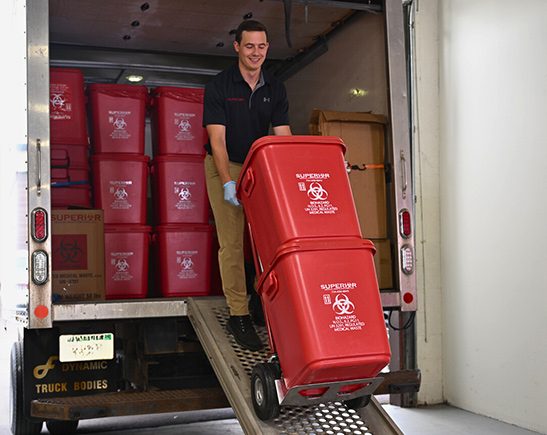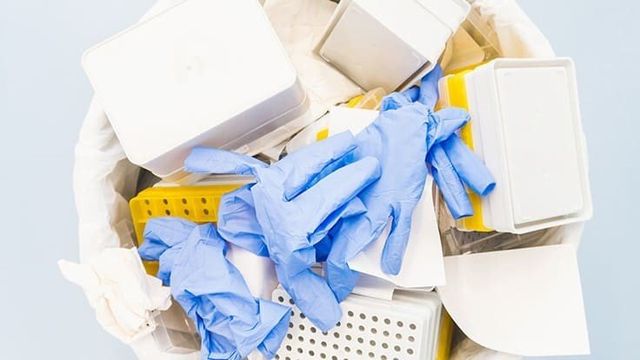Your Relied On Partner: Medical Waste Removal Services Tailored to Your Needs
Wiki Article
The Importance of Correct Medical Garbage Disposal: An Overview for Health Care Facilities
Proper clinical waste disposal is an essential aspect of medical care center management, making certain the safety and security and well-being of individuals, personnel, and the setting. From comprehending the different classifications of medical waste to abiding by governing demands, medical care centers need to adopt effective waste partition techniques and choose proper disposal approaches. The significance of correct clinical waste disposal goes past mere conformity; it is a duty that requires ongoing training and education and learning for personnel. In this guide, we will discover the various elements of medical waste disposal and highlight the necessary actions that health care centers need to take. By applying these practices, health care centers can minimize threats, protect public health and wellness, and contribute to a cleaner, more secure setting.Understanding Medical Waste Categories
Comprehending medical waste categories is critical for appropriate disposal in healthcare centers. Clinical waste is a wide term that includes different types of waste created in healthcare settings, such as clinics, healthcare facilities, and laboratories. Classifying clinical waste helps make certain that it is managed, kept, and disposed of securely and based on appropriate guidelines.There are several groups of medical waste that medical care facilities need to be conscious of. These classifications consist of infectious waste, sharps waste, pharmaceutical waste, chemical waste, and contaminated waste (medical waste disposal services with WasteX). Each category has certain characteristics and calls for various disposal techniques to reduce the danger of injury to healthcare workers, people, and the atmosphere
Transmittable waste, as an example, refers to waste infected with potentially contagious materials, such as blood, body fluids, and tissues. Sharps waste includes needles, syringes, and other sharp objects that can trigger injury or transfer infections. Pharmaceutical waste consists of expired or unused medications, while chemical waste includes hazardous chemicals used in medical treatments. Last but not least, radioactive waste includes materials contaminated with radioactive substances, such as nuclear medicine products.
Conformity With Regulatory Needs
Medical care centers need to make sure compliance with regulatory needs for proper clinical garbage disposal. Regulative bodies, such as the Epa (EPA) and the Occupational Safety and Wellness Administration (OSHA), have actually established policies and standards to safeguard public health and wellness and the atmosphere. These guidelines describe the proper handling, storage space, transportation, and disposal of clinical waste.Compliance with governing demands is vital for medical care facilities to stay clear of legal fines, reputational damage, and prospective harm to human health and wellness and the environment. Failing to adhere to these laws can lead to penalties, suits, and also the suspension or cancellation of operating licenses.
To make sure conformity, medical care facilities should establish comprehensive waste monitoring programs that include staff training, proper waste partition, and using ideal containers and tags. Regular audits and evaluations must likewise be carried out to identify any non-compliance problems and resolve them without delay.
It is important for health care centers to keep up to date with adjustments in laws and upgrade their waste administration techniques accordingly. This can be attained by actively keeping an eye on updates from regulative bodies and joining training programs and workshops.
Implementing Effective Waste Partition Practices
To make sure proper clinical garbage disposal, healthcare facilities must apply efficient waste partition methods. Waste segregation is a critical action in the overall waste monitoring procedure, as it assists reduce the danger of infection, protects against cross-contamination, and makes sure the risk-free disposal of different sorts of waste. Effective waste partition practices entail separating clinical waste into different categories based upon its qualities and potential dangers.One common practice is the partition of sharps waste, such as needles and scalpels, from various other kinds of medical waste. Sharps waste should be placed in puncture-resistant containers to stop injuries and possible infections. In addition, dangerous waste, such as chemicals and pharmaceuticals, must be separated from basic great site clinical waste to stop environmental contamination.
Correct labeling and color-coding of waste containers are important for efficient waste partition. Clear and visible tags must be put on each container to show the type of waste it has and any special handling needs - medical waste disposal services with WasteX. Additionally, color-coding can be made use of to differentiate in between different waste classifications, making it less complicated for health care team to recognize and get rid of of waste correctly
Regular training and education and learning for healthcare personnel is crucial for the successful execution of waste partition practices. Staff members need to be educated on the different waste groups, correct segregation strategies, and the importance of following waste administration methods. This will certainly help ensure compliance and consistency in waste segregation practices throughout the facility.
Picking Appropriate Disposal Techniques
Appropriate choice of proper disposal approaches is important in making sure the secure and eco liable administration of clinical waste in health care facilities. Health care view it facilities produce a selection of clinical waste, including sharps, contagious waste, pharmaceutical waste, and chemical waste - medical waste removal services. Each kind of waste needs particular disposal methods to reduce the risk of contamination, injury, and environmental injuryOne usual disposal approach for medical waste is incineration. Incineration entails the regulated burning of waste at heats. This approach is reliable in ruining microorganisms and minimizing the volume of waste. It can release damaging contaminants right into the air if not effectively regulated.

Chemical disinfection is another approach utilized for sure kinds of clinical waste, such as pharmaceutical waste. This approach makes use of chemicals to counteract or damage impurities. It is important to pick chemicals that are safe and ecologically pleasant.
In many cases, landfill disposal may appropriate for non-hazardous clinical waste (medical waste disposal services with WasteX). Proper partition and product packaging are crucial to avoid leakage or contamination.
Eventually, health care centers have to carefully assess the qualities of their clinical waste and choose appropriate disposal methods that prioritize safety and security, environmental security, and governing conformity. Normal training and tracking are important to make sure that medical care team follows correct disposal protocols.

Training and Educating Staff on Proper Disposal Treatments
Team education and learning and training play a vital function in guaranteeing the proper disposal of medical waste in health care Go Here centers. It is necessary that all personnel, consisting of medical professionals, registered nurses, service technicians, and assistance personnel, receive detailed training on proper disposal treatments. This training needs to cover the different kinds of medical waste, their potential hazards, and the proper methods for dealing with, setting apart, and throwing away them.One of the primary objectives of team education and learning and training is to ensure that all healthcare experts understand the significance of correct disposal procedures and the potential consequences of inappropriate waste administration. They require to be mindful of the threats related to clinical waste, such as the transmission of infections and the contamination of the setting. medical waste removal services. By understanding these dangers, employee will certainly be a lot more determined to follow correct disposal procedures and take the essential safety measures to protect themselves, their associates, and the area
Educating must likewise cover making use of individual protective tools (PPE) and the appropriate strategies for handling medical waste. Team member need to be enlightened on exactly how to identify and set apart various types of waste, such as sharps, infectious waste, and dangerous chemicals. They should also be trained on the proper usage of waste containers, such as sharps containers and biohazard bags, as well as the relevance of labeling and sealing these containers properly.
In addition, personnel education and training ought to consist of normal updates and correspondence course to make certain that health care specialists remain informed regarding the current regulations and ideal practices in medical waste disposal. This recurring education and learning is vital to preserve a high level of recognition and conformity among staff participants.
Conclusion
In verdict, correct medical waste disposal is of utmost value for healthcare facilities. Comprehending the various groups of medical waste and conforming with regulative needs ensures the safety and wellness of both health care employees and the basic public.From comprehending the various categories of clinical waste to abiding with regulative needs, healthcare facilities have to adopt efficient waste partition practices and select ideal disposal methods. These classifications consist of infectious waste, sharps waste, pharmaceutical waste, chemical waste, and radioactive waste.To make sure correct medical waste disposal, health care centers have to implement efficient waste partition techniques. Waste partition is a vital action in the total waste management process, as it assists lessen the threat of infection, protects against cross-contamination, and ensures the safe disposal of different types of waste. Medical care centers generate a variety of clinical waste, consisting of sharps, transmittable waste, pharmaceutical waste, and chemical waste.
Report this wiki page